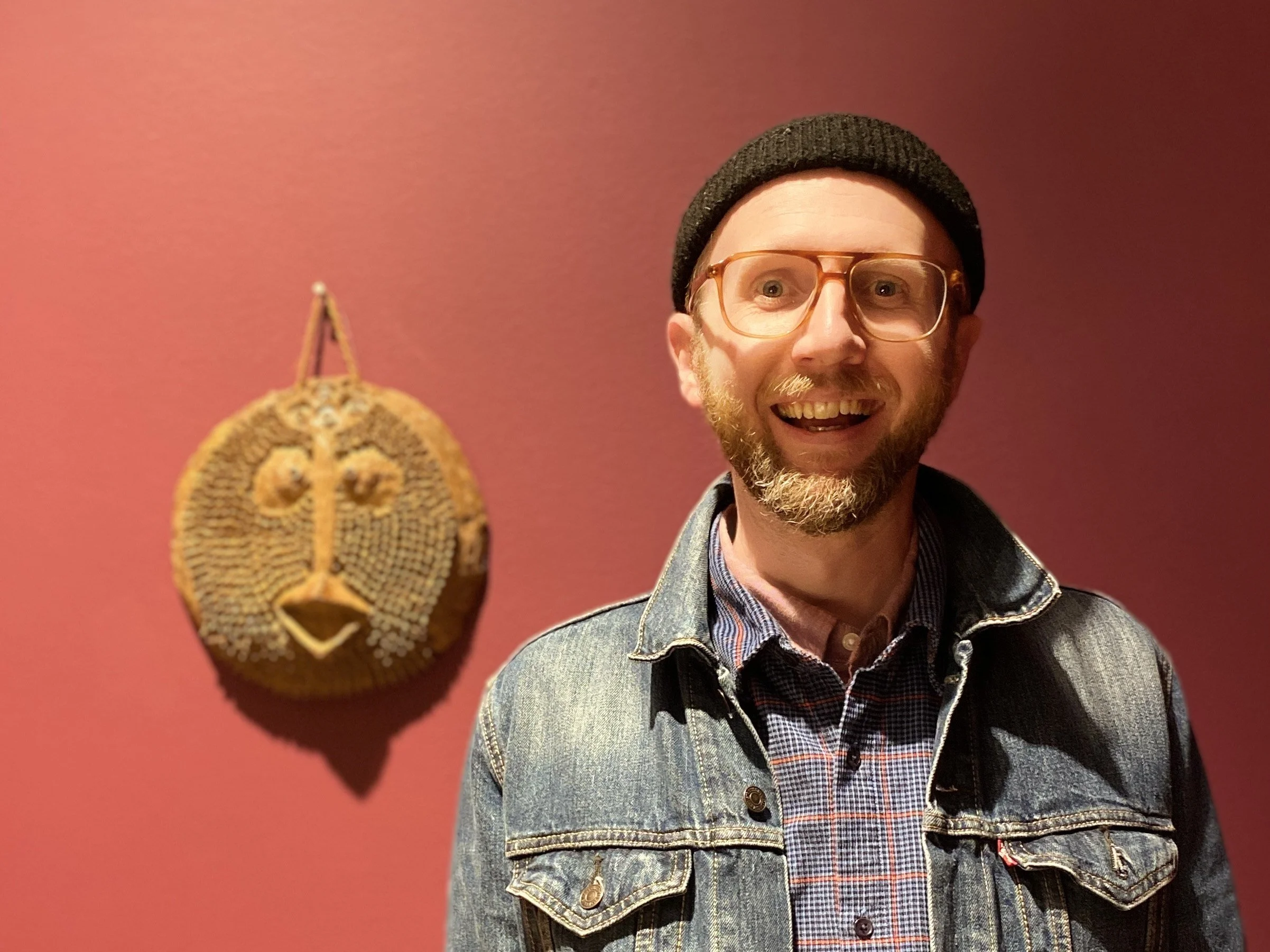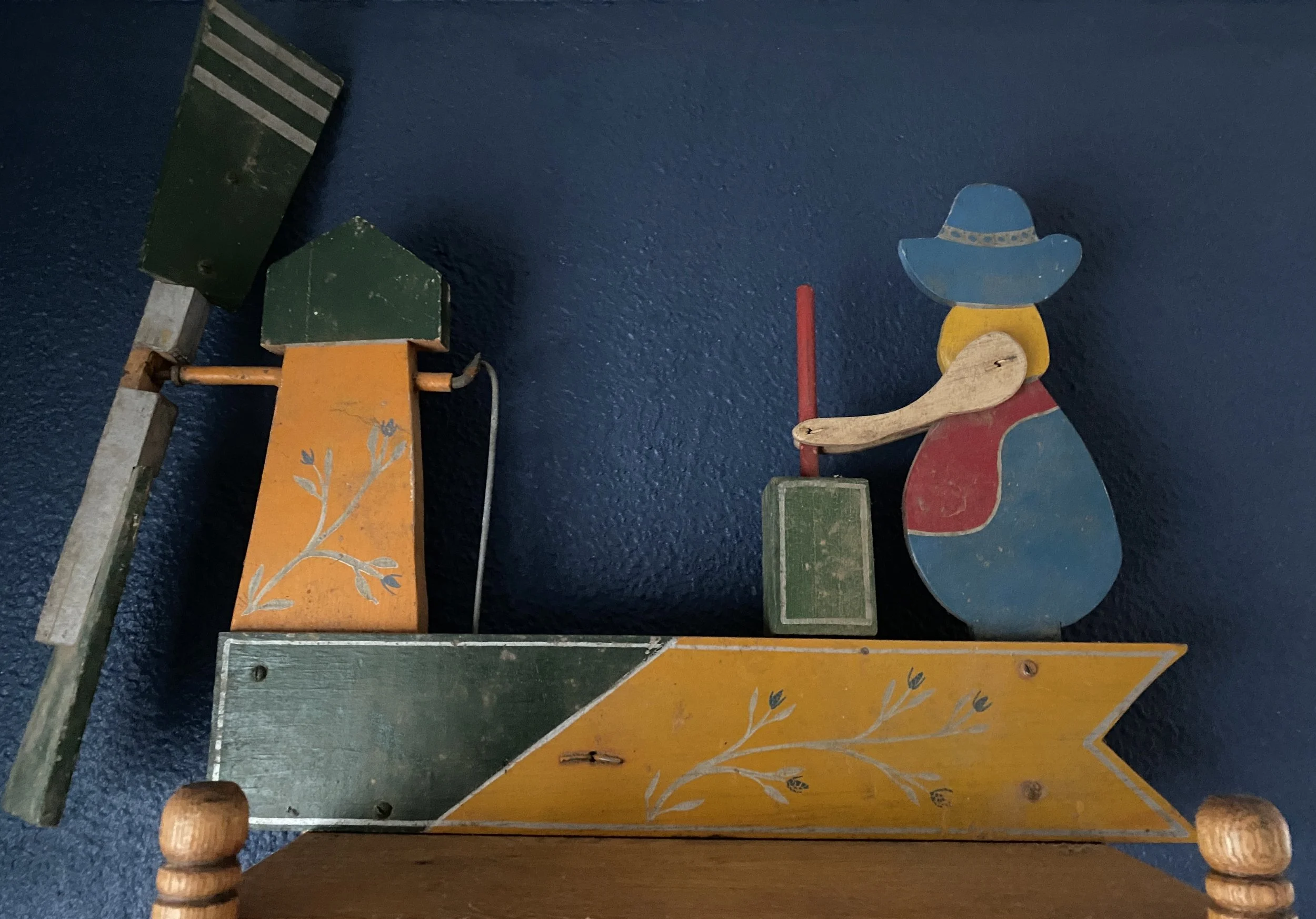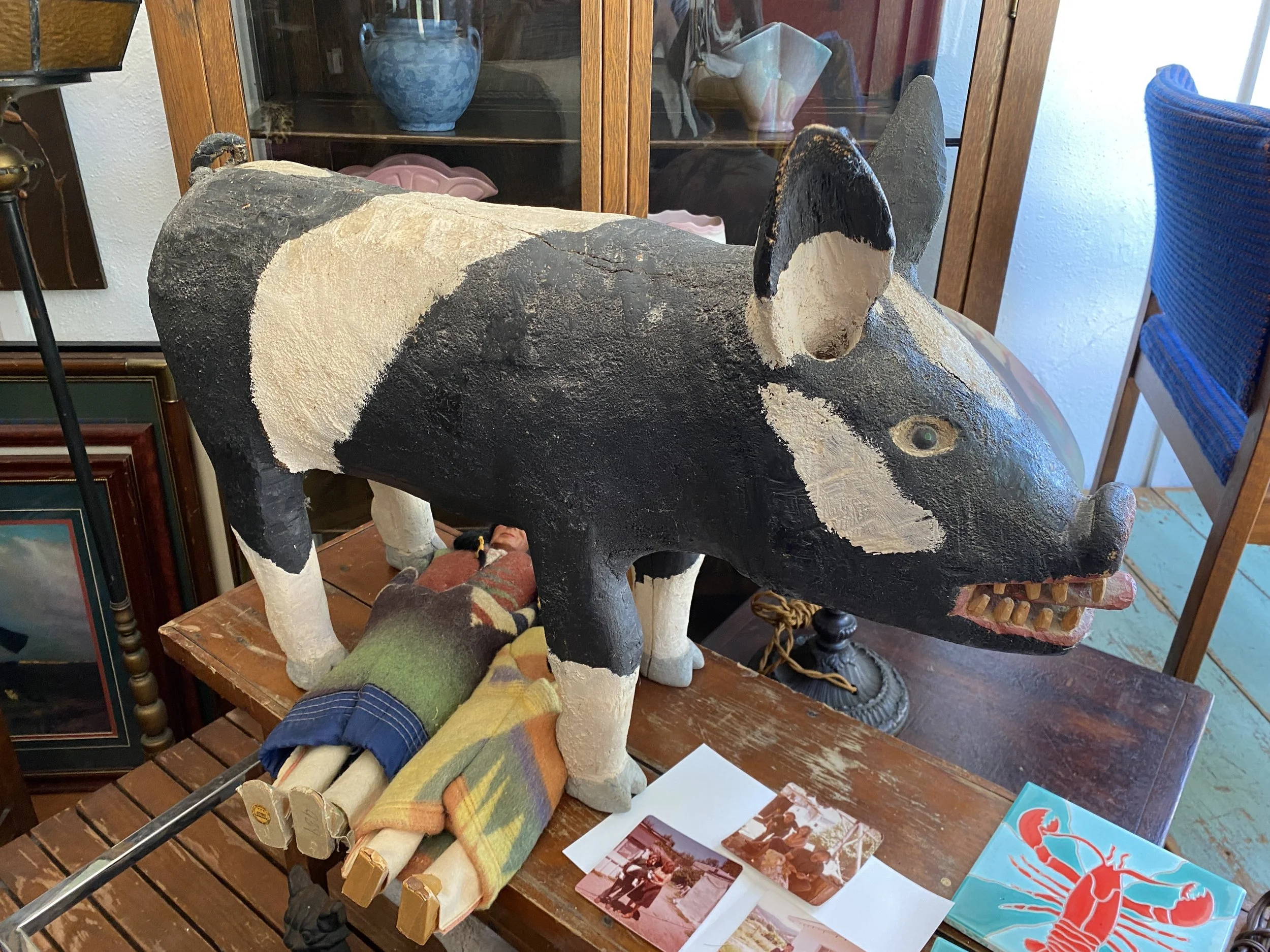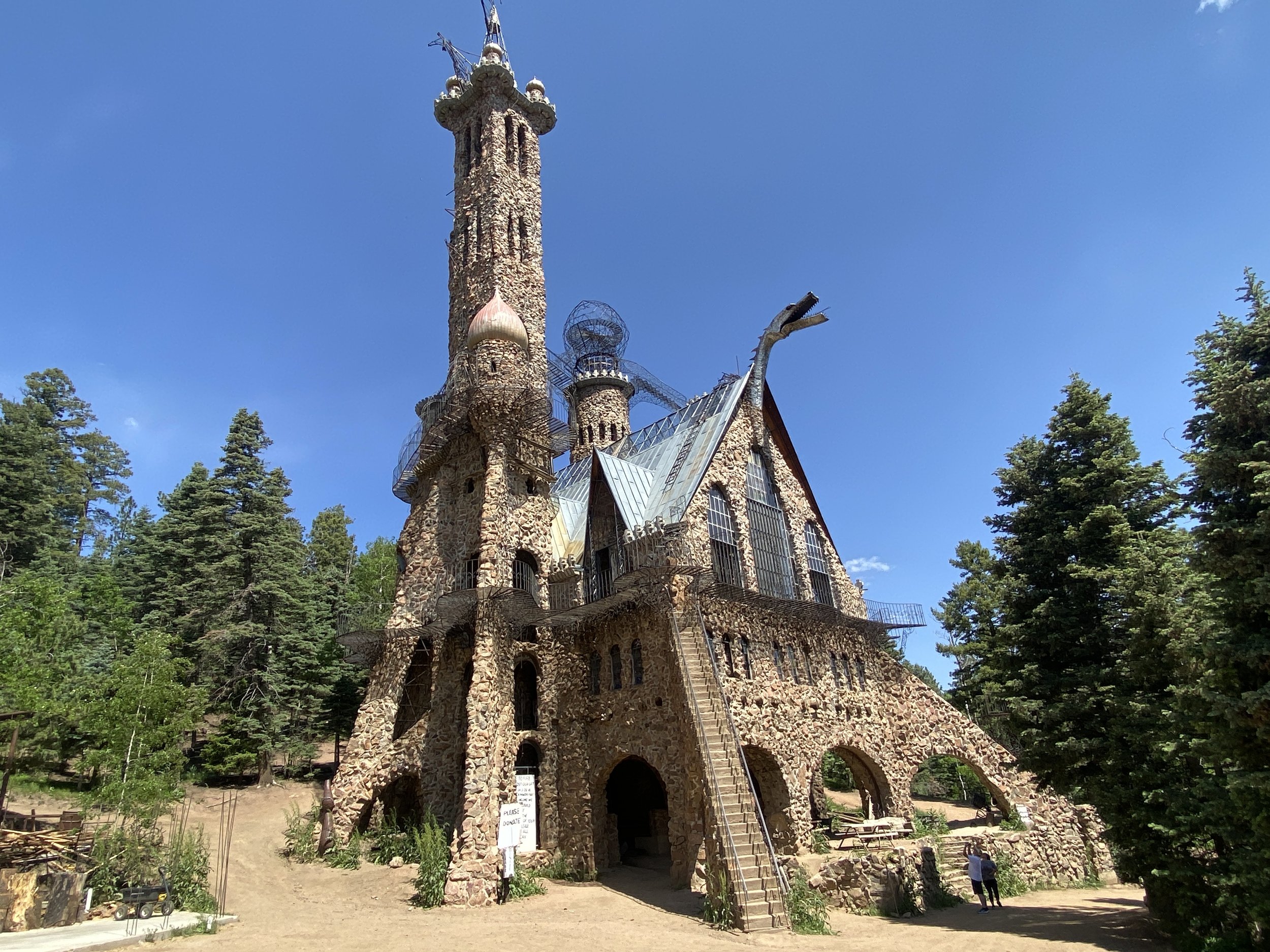ADAM OESTREICH, IOWA - MEET THE COLLECTOR SERIES PART SIXTY-NINE
Part sixty-nine of my Meet the Collector series is a little different. Yes this person is a collector, but in comparison to some others I interviewed, he is a relatively new collector, with his main passion being the promotion of art in this field to audiences young and old. He loves to learn, to research and to share his findings. Meet Adam Oestreich, AKA FolkArtwork on Instagram. Adam has amassed many followers through his true love of outsider, self-taught and folk artists from around the world, beginning his own small collection at home. It was a pleasure to get to know Adam more, and I hope you enjoy learning more about the man behind the popular account!
Adam at the Shinichi Sawada exhibition, New York, 2023
1. Firstly, can you tell us a bit about your background?
I was born and raised in a small town in Iowa, right on the Mississippi River. Throughout my life, I have had a variety of interests, from track and field to improv comedy and always, art. From a very early age I always enjoyed art and wanted to do something with that as I got older. I didn’t know exactly what to do, so in college, I got a degree in Graphic Design and worked odds-and-end jobs for a few years including as a designer for a magazine, designing t-shirts and posters/event signage for sporting events across the country and a few stints as a social media manager for various companies. I spent nearly ten years after college living in Austin, Texas, where I met my wife, and for the past five years have been living in Des Moines, Iowa, with my wife and two kids, teaching, making, and looking at art as much as possible.
2. When did your interest in the field of outsider/folk art begin?
In the fall of 2018, I was back home visiting my family for the holidays, and we decided to go to our local art museum to kill some time before dinner. The museum was the Figge Art Museum in Davenport, Iowa, and there just so happened to be an exhibit titled “William Hawkins: An Imaginative Geography” taking place. The exhibit completely blew me away, and I instantly fell in love with William Hawkins. I wanted to know as much as possible about Hawkins, this wonderfully expressive type of art, and for the next five years, I’ve spent nearly every day learning a little more about the world of outsider, self-taught, and folk artists.
William Hawkins exhibit at Figge Art Museum, NYC, 1985 (This piece is titled Prudential)
3. When did you become a collector of this art? How many pieces do you think are in your collection now? Do you display many of them in your home, or in other places?
We purchased our home in the summer of 2020 and, ever since, have been collecting and adding things slowly but surely. The first piece we bought when we moved in was a great solar system-looking painting from an artist that works with the Austin, Texas-based “Art From The Streets.” At the time, my son was obsessed with the planets so we had to get something special for his room. All of the artwork I’ve collected is in our home, where I’m lucky enough to have free reign to display things where I please. My wife is very patient with me, if she absolutely loves a piece, it will go in the living room or dining room, and if she isn’t so sure about a piece, I’m lucky to have two young boys who love everything I bring home so I can hang them up on their walls!
4. You said you stopped making your own art once you saw the art of some of the greats like William Hawkins – can you elaborate a little more on this?
You know, now it kind of feels like a bit of a cop-out. I haven’t really made my own art ever since my children were born, since I started teaching, and since I started @folkartwork. There are only so many hours in a day, so it was a good excuse for me as I don’t create or make any art of my own. I’d like to, but currently, I don’t have the medium/materials or, quite yet, the point of view I’d like to share to dedicate time to putting artwork out there. And, because William Hawkins, among countless others, makes just the most jaw-dropping artwork and for a good majority of the art world, they aren’t aware of him, or Maria Prymachenko, or an Esteban Whiteside or Jackie Bradshaw (shameless plug for a few friends!), I’d rather dedicate my time to using the platform and energy I have to make sure people are aware of this brilliant artwork that already exists.
5. What style of work, if any, is of particular interest to you within this field? (for example is it embroidery, drawing, painting, sculpture, etc.)
As of late, embroidery! I go crazy for any quilt or hooked rug I see. I think, largely in part, it is because I’ve tried to cross-stitch and sew, and it seems so beyond me how some people can make such incredible artwork with their fingers like this. It could also be because I’m running out of wall space, but I’ve been recently loving sculptures and just bought my first whirligig at an antique store. I’m also going to have to blame, thankfully, the Museum of International Folk Art in Santa Fe for this because their collection of embroidery and sculpture is otherworldly, and I was fortunate to spend time there this past summer.
Artwork by Fernando Segovia, from Art From The Streets
6. Would you say you had a favourite artist or piece of work within your collection? And why?
My favorite piece would have to be the Felipe Benito Archuleta pig that is proudly displayed in our bedroom. It was created by Archuleta in c.1978. It’s probably about 3 feet long and 2 feet wide made out of wood and my son and I found it at our favorite antique store. Unfortunately, this antique store burned to the ground last summer, and anytime my son looks at the pig, he says, “I’m glad we saved him from the fire.” Because of that, it holds a special place in my heart, but it was the first time I felt that looking at outsider art every day really paid off, as the second I saw it standing in the antique store, I knew it was a piece created by Archuleta, and I knew it had to come up with me.
7. Is there an artist that you wish was part of your collection, that may be too expensive or a little out of reach? And why that artist?
There are too many to list! The easy answer, of course, would be William Hawkins. I dream of owning a William Hawkins one day, but for now, it is a little out of my price range. Other artists like Maria Prymachenko, the great Ukrainian folk artist, and Norval Morrisseau, the brilliant Canadian Indigenous artist, would be incredible to own, but due to their rarity seem unlikely. Those three artists, when I first started learning more about folk art and self-taught art, were the three that always stood out to me, the vibrant colors, the expressive nature of their work, and the imaginative storytelling. I would love to own works by any of those artists. Oh, and I would love to buy a piece by Shinichi Sawada one day!
The first whirligig I bought
8. Where would you say you buy most of your work from: a studio, art fairs, exhibitions, auctions, or direct from artists?
Most of the work I acquire comes directly from artists. I have been fortunate enough to meet and get to know so many amazing artists on Instagram, and I try to support them as much as possible. I’m also a huge fan of progressive arts studios like SAGE Studio & Gallery in Austin, Texas and Project Onward in Chicago, and I love purchasing art from them as much as possible. And if I find something in my price range that I can’t live without, I will pull the trigger at an auction, as those are always fun and exciting to watch.
9. What is your favourite outsider environment you have visited to date? And which one is the top of your hit list?
This past summer, I dragged my parents and two young children through the backwoods of Colorado, and we explored Bishop Castle. It was one of the more unreal places I have ever been, and while we didn’t make it to the top of the castle all built by one man, as much as my six-year-old wanted to, it was completely and utterly mind-blowing. I also visited MT Ligget’s Political Totems in rural Kansas, which was mesmerizing and overwhelming in the best possible way. I’d be remiss if I didn’t mention that Iowa has a few great environments too, including The Grotto of Redemption, which is a must-see for anyone interested in art environments. I really need to make it out to the West Coast to see all they have to offer, specifically Salvation Mountain created by Leonard Knight in the California desert.
10. Is there an exhibition in this field of art that you have felt has been particularly important? And why? (it doesn’t need to be one you have seen in-person)
The Outsider Art Fair, to me, is just the best weekend in all of art. Granted, I’m new to this world and a small town kid from Iowa, so to get to NYC for a weekend to be able to see in person all of my favorite artists in one place, it doesn’t get much better. Everyone I meet at the Outsider Art Fair is delightful, and having the best of times. What they’ve been able to do in over 30 years, how it has evolved is also quite remarkable. Last year, I was fortunate enough to spend an extended period of time talking to folks like Aarne Anton and Duff Lindsay hearing about how far it’s come from the lobby of a hotel until now, and also talking to Tom di Maria of Creative Growth, in how when the fair started it wasn’t known if including progressive art studios was a right fit for now, and now thirty years later Creative Growth is seemingly headlining the Outsider Art Fair to celebrate their 50th anniversary.
My favorite piece that I’ve bought is the Felipe Benito Archuleta pig
11. Are there any people within this field that you feel have been particularly important to pave the way for where the field is at now?
Speaking of art environments, there are a few people who have dedicated their lives to making sure these places are saved and highlighted, no more in my opinion than Larry Harris, who runs NarrowLarry.com. I’m still such a newcomer to this space so I feel like I would obviously be missing someone and would hate to leave them off a list, but there are so many great people who, in their little pockets, have done so much for this field and probably don’t get their due, like Bruce and Julie Webb as well as Jay Wehnert for all the great art out of Texas. I took an incredible folk art class last year by Isa Segalovich who is a young, anti-authoritarian folk art historian who I think is doing amazing things for the field, and I’m sure there are countless people out there who are doing invaluable things that we aren’t even aware of.
12. So, I know of you through your fascinating Instagram page and newsletter @folkartwork. What inspired you to set this up, and has your mission with it changed over the years?
The inspiration for this came the day after I visited the William Hawkins exhibit back in 2018. I had been a fan of Twitter and Instagram accounts at the time, specifically one called @41strange that just posted some hidden, unknown gems of art, oddities, film, history, and so on – and I wanted to be a part of it, but with works by artists like William Hawkins. As I clearly didn’t know what I was doing at first, starting the account called @folkartwork but showing lots of works by outsider artists, maybe not exactly folk artists. I have been growing, and it has been evolving every year. My mission has been and continues to be to showcase as much great art by as many artists whom the general public may not know about as possible. And with each passing year, and with a little more reach and popularity each year, I have been able to do that in new and exciting ways.
13. Some people may not know this, but you’re also an art teacher, can you tell us a little more about that? And do you often share outsider and folk artists’ works with your students? What sort of reaction do you get to it?
Yeah, for almost the same amount of time I have been running @folkartwork I have been studying to be and being an art teacher at a local high school. I teach primarily 9th and 10th-grade students everything from Intro to Art to Graphic Design and Photography, as well as my favorite subject the past two years, Art History. In almost all of my classes, I will incorporate folk artists and some discussion or project inspired by these artists I am so passionately engaged in. This past week, my photography students created frames inspired by, go figure, William Hawkins. Our first project of the year is to find out more about our culture and background and incorporate a folk art design into their sketchbooks, and the last project of my Art History class is to research one self-taught artist and recreate one work of art by them. I believe that these artists are perfect to share with high school students because they are consumed with getting everything perfect and creating the best possible art in the shortest amount of time. It has been fun to get them out of their comfort zone and learn about some artists who they may have more in common with, and largely, they are somewhat impressed – especially when they find out how much some of these works by self-taught artists sell for!
Artwork by William Douglas from Project Onward, Chicago
14. What motivates to keep your Instagram and newsletter going alongside your teaching job, as I imagine both are quite time consuming?
It’s been the most fun and fulfilling thing I’ve ever done. I’d be lying if I didn’t say it is cool to almost have one hundred thousand followers on Instagram, so I do feel a bit of pressure to keep that going, but at the end of the day it’s opened a ton of doors for me to meet great artists, gallerists, academics, and wonderful people like you! I never dreamed that this account would have the success it did, and I think I would still be doing it even if no one followed me. Through it all, everyone I have met has been extremely nice and helpful along my journey, and at the end of the day I just love seeing art. I love learning about new artists, why they made the art they did and how they made it. How they just made it for themselves, and it helped them in some way. On the days when I am most stressed from teaching or chasing my two boys around my home, it’s a fantastic way to alleviate some stress to sit down on my computer or in front of a book and look at some beautiful art.
15. If there was one thing you could say to younger generations today about the kind of art you share and why they should be looking at it, what would you say?
This is not an original thought by any means, but just make the art you want to make. Don’t worry about what your friends, your colleagues, your fellow artists, and especially your followers on social media have to say. As long as you keep making what you want to make, growing as a person and an artist and pushing boundaries, the rest will follow.
16. A conflicted term at present, but can you tell us about your opinion of the term outsider art, how you feel about it and if there are any other words that you think we should be using instead? And in America do you think this term is used less in comparison to a term like folk art?
I have yet to finish it – it’s a very big book, but I really like the point of view your friend and colleague, the great Lisa Slominski, conveyed in her book “Non-Conformers”. I do think the term Outsider Art can be misleading at times, perhaps even demeaning, and it now seems like people are trying to be called “Outsider” so they can either find a home or a nice term to throw on their Instagram bio. I may be thinking too highly of myself in my very small online world, but I feel I probably haven’t helped much with this. I remember early on when I would share work by an artist, and someone would comment, “They are not an outsider artist.” It would kind of bother me, and I would try to do better. But I do think that these labels don’t really matter. I like sharing art by folk artists, self-taught artists, artists with intellectual/developmental disabilities, and artists who spent years in art school and make some really cool and interesting art. As long as the meaning is there or the story is great, and at the end of the day, the art is great, the term shouldn’t matter. But if I had to choose, I would like “Non-Conformers,” in my opinion, art by artists who did it their way.
Bishop Castle, Outsider art environment, Colorado
17. Last year you started a shop side to your business (the FolkArtwork Collective) and started working with a few artists to sell their work. What prompted this, and how has it been going for you?
What prompted the FolkArtwork Collective was seeing a lot of super-talented artists on Instagram, making incredible artwork but not having a successful time selling artwork. I see a lot of artists selling work on their Instagram stories and wanted to try and build a place for artists, specifically self-taught artists, to go where they didn’t have to build a website, market themselves, and keep up with sales. I have the platform, I want to share that and help these artists not have to worry about the business side of art as much, just the art making. If an artist doesn’t have gallery representation or an incredibly large social media account, it can be hard to make a living just being an artist, and I wanted to do the very little I could to step in and help. I wasn’t quite sure what to expect from one year of selling art, but it has been going really well for the ten artists currently on site, and I hope to continue to add more artists this year and sell them as much artwork as we can.
18. What are you most looking forward to in the realms of outsider and folk art this year?
I really want to see the Nellie Mae Rowe documentary, ‘This World Is Not My Own,’ and I’m really excited to learn and discover more artists that I didn’t know about and have their art knock my socks off.
19. Is there anything else you would like to add?
Thank you so much for this opportunity, and thank you for always being so kind and supportive every time we talk!






